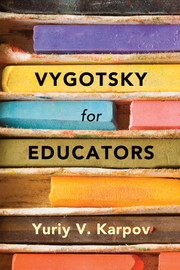Book contents
- Frontmatter
- Dedication
- Contents
- List of Figures
- Acknowledgments
- Introduction
- Part I Mediation from Birth through Adolescence
- 1 The Vygotskian Notion of Mediation as the Major Determinant of Children’s Learning and Development
- 2 First Year of Life
- 3 Second and Third Years
- 4 Three- to Six-Year-Olds
- 5 Mediation of Preschoolers’ Activities to Promote School Readiness
- 6 Learning at School: Children Not Only Learn; They Develop As Well
- 7 Understand Adolescents and Make a Difference!
- Part II School: What to Teach and How to Teach
- Notes
- Index
4 - Three- to Six-Year-Olds
Why Sociodramatic Play Is Important and How to Promote It
Published online by Cambridge University Press: 05 June 2014
- Frontmatter
- Dedication
- Contents
- List of Figures
- Acknowledgments
- Introduction
- Part I Mediation from Birth through Adolescence
- 1 The Vygotskian Notion of Mediation as the Major Determinant of Children’s Learning and Development
- 2 First Year of Life
- 3 Second and Third Years
- 4 Three- to Six-Year-Olds
- 5 Mediation of Preschoolers’ Activities to Promote School Readiness
- 6 Learning at School: Children Not Only Learn; They Develop As Well
- 7 Understand Adolescents and Make a Difference!
- Part II School: What to Teach and How to Teach
- Notes
- Index
Summary
Sociodramatic play is children’s joint role-play, in which they choose a plot that reflects a certain aspect of social relations (e.g., buying something in a store), distribute roles (e.g., a seller and buyers), and play together imitating the chosen aspect of social relations. The traditional view of sociodramatic play is that it is children’s free and spontaneous activity, in which they do whatever they want, liberating themselves from any rules and social pressure; therefore, adults are not supposed to interfere with children’s play.
The Vygotskians have developed a quite different approach to sociodramatic play. From their point of view, children play not because they want to liberate themselves from social pressure. Just the opposite; as discussed in the previous chapter, by the age of three years, children develop a strong interest in the world of adults, and they are looking forward to becoming a part of this world. In industrialized societies, however, children cannot fulfill this desire directly: They cannot be doctors or firefighters. That is why they attempt to “penetrate” the world of adults through imitating and exploring social roles and relations in the course of sociodramatic play.
- Type
- Chapter
- Information
- Vygotsky for Educators , pp. 59 - 74Publisher: Cambridge University PressPrint publication year: 2014

